Christmas on the Western Front
If you’ve read “(Not) Home for Christmas, Part 1”, you’ve seen this photo, and you also know how Emil and the Augustana bandsmen had spent Christmas of 1917. Christmas, 1918 found Emil “billeted” with the Bougnot family in Doulaincourt, Hte Marne, with Theo Lenz as a roommate. The Armistice had been signed the previous month, but there was still one more Christmas before the bandsmen would be home.
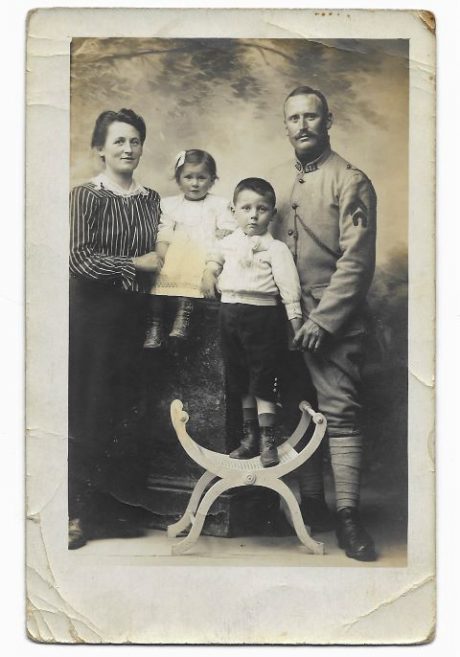
To describe the family they stayed with, Emil wrote: The Bougnot family were refugees from Alsace-Lorraine. The father was a blacksmith in the French army and managed to come home frequently. Lenz and I were billeted in the back room with the goats and rabbits. Others were billeted in the lofts, here and there. French homes, at least in the small towns, had everything under one roof.
I found a website with some photos of refugees during the first world war. I couldn’t figure out how to save individual photos, (although the site does say they are mostly copyright expired). You can click here to see the Refugees photos on “First World War.com”. The images looked just like what Emil described on page 80 of “The Forgotten Bandsmen”: As was usual, the roads were crowded with every kind of traffic. Push carts and horse carts, loaded with household furniture. Where did they all come from! All roads were the same!
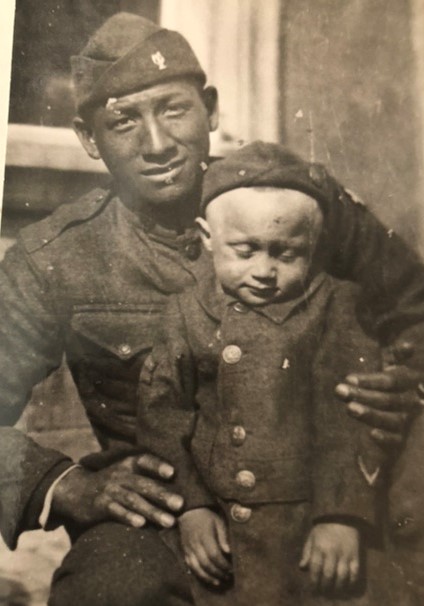
There were two small children in the Bougnot family: Beth, about 3, and Jules, about 4. Both of them were malnourished, so I began to take Jules with me for our noonday meal. Then I filled my mess kit with good cooked food and gave to the mother and her little daughter. Needless to say, they soon put on a little weight. I also managed to tailor a khaki uniform for Jules and found a campaign hat that almost fit.

Nels Johnson in Ludington, Michigan. 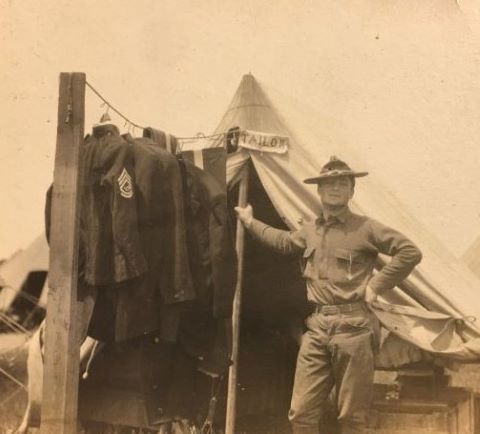
Military tailor (not Emil).
You may remember that Emil’s father, Nels Johnson, was a merchant tailor. In August of 1917, during military training, Emil obtained a nine-day leave, “to learn the tailor trade in a few easy lessons”. During this time he was able to fashion a miniature uniform for his youngest brother, Kermit. It was after this that Emil became the “official” regiment tailor.
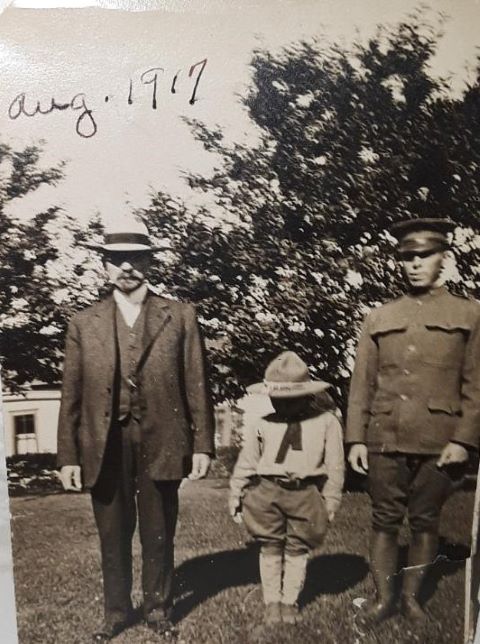
Having been raised in a large family with quite a few younger siblings, we can imagine that for his second Christmas away from home, Emil’s thoughts would turn to the children. And so they did.
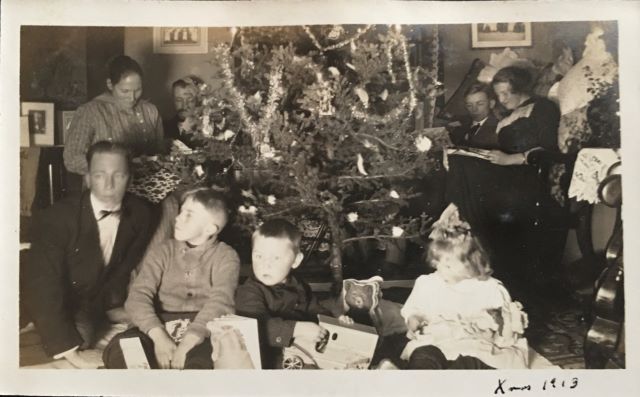

Emil continued: There were several children on or near our street and so Lenz and I decided to do something special for them. We cut down a small spruce tree, made candles out of government issue, forming holders by bending wires around a pup tent stake. The wire was long enough to be attached to the main trunk of the tree. We collected money, and bought all the sweets and biscuits available, which were not too plentiful at that. I had previously asked Madame Bougnot if there were any broken toys. There was a small doll, which I wired together and then sewed a dress for. But there were few other toys available.

The French called Santa Claus “Le Pere Noël”. When Christmas arrived, the kitchen was all but packed with children. Lenz had rigged himself up with a beard (cotton) and a long wicker basket. St. Nicholas did not come by way of the chimney, but through the door. I was the only soldier in the room and when Lenz came in, the children all fell on their knees with folded hands. Their faces shone like angels’ faces and joy was complete. Later some of the other men were allowed to come in for a few minutes.
Just imagine the excitement felt by the Bougnot children and their friends! And the thought of Theodore Lenz, after all I’ve read about him in “Grandpa’s Book”, with a cotton beard distributing presents, makes me smile. Emil kept in touch with the Bougnots for some time, and they even sent him a photo of Jules on his confirmation day.
There were several articles in the Ludington Daily News about local soldiers who spent Christmas 1918 overseas. Among them was Corporal F.C. Glowaeki of Fifth Street, who attended midnight mass in Tours, France and then helped make Christmas dinner with his unit. It wasn’t until he went to the movies at the YMCA and saw a little girl decorating her doll that he really realized what day it was. Private John Loftis from Fountain wrote of a lonely Christmas and “cooties”, and Wagoner Floyd McVicker spent Christmas with a German family who had a son in the US. I don’t know when or if these men arrived home to Michigan, but with some research I’m sure I could find out.
Since we’re thinking about Christmas (in August!) I’ll leave you with two more pictures of adorable Kermit and Leona. I’m not sure of the dates, but since they were born in 1909 and 1910, we can have a vague idea. Somehow, now that I’m writing this, I can’t help thinking about all the children whose big brothers (or fathers) didn’t come home from the war.

With three sons in the military, two of whom were overseas, it couldn’t have been easy for parents Nels and Anna Caroline. I can only imagine they tried their best to keep the little ones positive, and to keep their faith in God strong. The fact that John Alfred, Nels Ivar, and Emil all survived the “war to end all wars” tells me that our family was extremely blessed. Each suffered their own war-related disabilities, but they were thankful to be together and to be home.


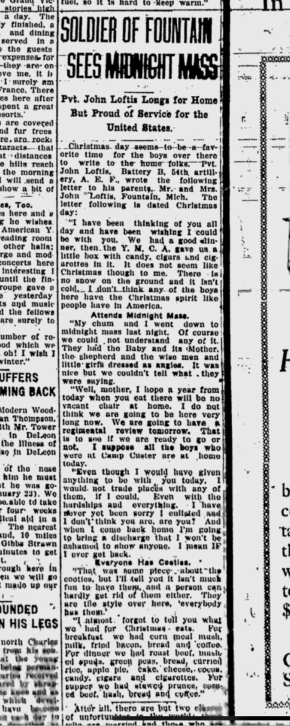



These are such fascinating and poignant stories, Debra. At least a little magic was brought into the lives of those families at Christmas. 🙂
I’m glad you enjoy reading them! I think little kids like the Bougnots probably remembered those experiences all their lives.
Wonderful memories and great photos, Memories are what keep the people we have loved alive forever,
You’re right, Sandra. And what’s interesting is that reading my grandpa’s book has showed me a whole side of him I never knew growing up. 😊
Lulu: “Kermit’s hat provides him almost as much shade as Dada’s hat does! Almost!”
Lol shade is important for humans!